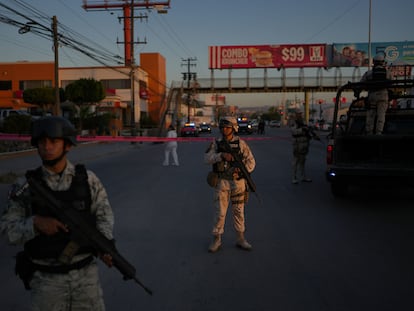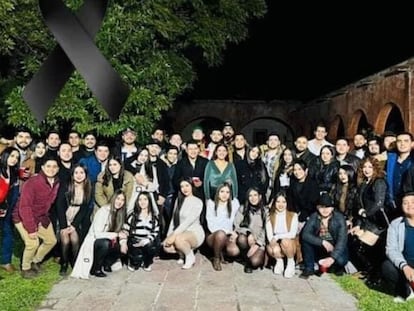The Celaya police are pursued by crime: ‘It’s a war against a guerrilla army’
Since 2022, officers and criminals have been fighting an all-out battle in one of Guanajuato’s most important cities. In the last year, 22 agents have been killed. EL PAÍS accompanies a team on their patrol
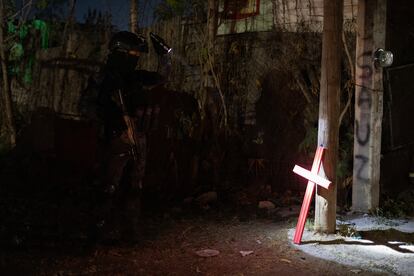

Someone left a red cross in this dusty corner, next to the asphalt. It is bright red and looks freshly painted. There are no flowers, no message. Just the cross. Silently, policeman Javier illuminates it with his flashlight. It is nighttime. The wind is blowing. “That’s where one of them stayed,” he says. The others, he adds, tried to flee down a dirt road where the highway ends and enters the streets of Pelavacas, one of Celaya’s neighborhoods. Javier walks along it now. Idly, he shines his light back and forth. He is not looking for anything in particular. It’s just something to do as the night progresses.
The victim and the others are part of the criminal group that clashed with municipal police on February 1 in Pelavacas. Three of them died, as did two police officers. It was the latest in a long list of attacks against members of the police force. Others would follow. In the last calendar year, at least 22 police officers have been killed in Celaya, one of the most important cities in the central Mexican state of Guanajuato. There is no similar situation in any other city in the country, no war as evident as the one experienced here.
The question is why. Why is this battle being waged in Celaya and not in Leon, Irapuato or Salamanca? Or at least not with the same fixation. For years, Guanajuato has been experiencing a brutal crisis of violence, with thousands of murders, disappearances, massacres.... In December alone, Celaya and its metropolitan area recorded two of the worst recent killings, the murder of 11 young people at a party, and the murder of another six, days earlier, who were found shot to death next to the university. Criminal organizations have employed aggressive tactics to avoid the authorities, such as blocking highways with burning cars and throwing sharp-edged iron on the asphalt. But Celaya is different: it’s not about eluding the authorities; it’s about eliminating them.

Criminals have attacked both on-duty and off-duty police officers. They have done so in groups and alone. They’ve shot officers and thrown grenades at them. They have not cared that the police were with their families, like the officer who was shot dead with her daughter one morning on her way to school last month. It has also happened semi-coincidentally — casualties in the context of a war — like the February 1 attack in Pelavacas. The agents were patrolling their beat when they came across a van that seemed suspicious to them. They began to follow it and ended up being ambushed in their pursuit.
“It was about one o’clock in the afternoon,” explains Javier, a pseudonym he has chosen for security reasons. “Four colleagues were in the patrol truck, two in the cabin and two in the back,” he explains. “The ones in the back were carrying rifles and standing on the flatbed,” Javier continues. “In the chase, they didn’t notice, but at least two criminals got out of the car and took cover here,” he says, pointing to the red cross and a nearby tree.
The criminals were preparing their ambush. They waited just a few seconds and, when the patrol car arrived, they started shooting. “They hit the driver of the patrol car, which crashed into a light pole. The passenger got out and tried to take shelter in the back, but he was hit when he tried to move,” the officer continued. The two policemen who were on the flatbed got out with their rifles and chased the assassins. At some point, they hit the one who was where the red cross now lies. Meters ahead, they hit two more, who fell wounded and died later. The rest of the criminal gang drove their van to the end of the road. Then, they abandoned it and ran away.
At the end of the road, on top of the dusty ground, small piles of glass complete officer Javier’s story tonight. They are the shards of glass from the windows of the attackers’ van. Javier’s colleague, sturdy as the trunk of a willow tree, illuminates the surrounding fields, the vehicle lying next to the glass. Now, he says, Celaya’s municipal police can no longer go out in individual patrol cars. They always go two by two. “Really, it’s a war here, a war against an army expert in guerrilla warfare,” he murmurs, as if he weren’t saying anything important.
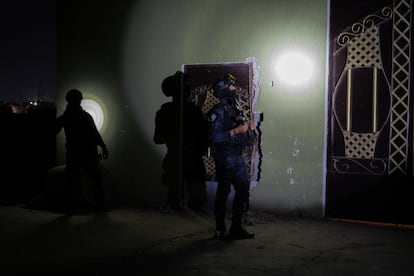
Santa Rosa
The local Big Brother, that is, the control center of the public security camera network — also known as C-4 — operates in an unmarked building on the outskirts of Celaya. Jesús Rivera, the city’s police chief since October 2021, says that currently, around 1,500 cameras monitor the streets of the municipality, which has around half a million inhabitants. “It’s one of the changes we’ve made here,” he explains. “We didn’t coordinate analysis, planning and operations on the ground. And now we’re directing and improving the operation from here.”
A former federal police officer, Rivera graduated in the mid-1990s and witnessed all the changes that successive Mexican governments implemented in the force, from the Federal Highway Police, to the preventive police, to the federal police, to most recently the National Guard, Andrés Manuel López Obrador’s brainchild. In 2021, Rivera requested a leave of absence and came to Celaya, which he knew from his last assignment in the federal police, when he coordinated the force in Guanajuato. Rivera talks a lot. His many ideas flow forth easily. He repeats one of them like a mantra: “Security is not an ideological issue, but a technical one.”
The police chief points to a reason for why what is happening here is taking place, why his police, many ex-federal officers like himself — 70 percent of around 1,000, he says — are facing this onslaught at the hands of organized crime. “Celaya is the origin of the local criminal group. They feed on it financially [through the] theft of vehicles, banks, cargo, drugs, everything,” he explains. “And we have weakened them substantially.” Rivera does not say its name, but he is referring to the Santa Rosa de Lima Cartel, a regional criminal organization, nurtured in the heat of fuel theft, the famous huachicol. Rivera speaks of important arrests, reprisals, confiscations…
The nearly twenty years during which the country has been at the mercy of the wars against organized crime attest to the fact that reality is often more complex. In Mexico, organized crime’s existence depends on its relationship with the authorities; criminal organizations’ hierarchy, fluidity and direction change accordingly. Rivera himself points out that since he arrived, at least 300 agents have left the department; he and his team forced half of them out for alleged corruption. “We had many corruption problems, and we are not exempt from them: leaks, omissions, improper activities,” he laments.
The numbers support part of his hypothesis. The National Statistics Institute shows an extraordinary decrease in the number of murders in the city from 2021 to 2022, around 1,000. Although the institute has not provided data for 2023, the Executive Secretariat of the National Public Security System, which shares its statistics more quickly, shows a further decline in Guanajuato last year. Similarly, Rivera points out that, since 2021, vehicle theft has dropped almost 90 percent, and they have ended bank robbery. However, the Celaya Citizen Observatory notes that extortion and business robbery rates remain very high.
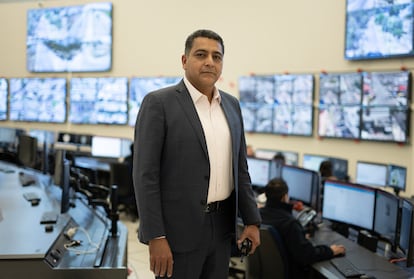
From outside
“There have been weeks when there was an attack per day,” says agent Sofia, next to the C-4 operation screens. She is not wrong. With the Pelavacas case, January and February have been especially painful. In just two months, 10 agents have been killed. Sofia — a pseudonym — recalls the events of January 25, when criminals ambushed and killed four agents in one fell swoop; it happened not far from here, in Rincón Tamayo, the largest neighborhood in the south of the city.
“[Our] colleagues asked for support by radio once, but they didn’t speak anymore. That’s when we learned the operational cell to which they belonged, but not who they were or where they were.” From the operation module where Sofia works, the agents in charge that day took four minutes to locate the ambushed patrol car: it was the only police car in Celaya that had stopped moving. Shortly after, other patrol cars arrived and saw their colleagues’ car totaled. All the officers were dead.
The attack is understood as the zenith of a long-running battle. Chief Rivera puts the start of hostilities at the end of 2022, although things had not been quiet before that. In August, criminals had assassinated the mayor’s son in the city as he was leaving a pharmacy. Many in Celaya saw that as a challenge by organized crime. Rivera prefers not to say whether the attack was related to his line of work, but he does not rule it out. However, in November, things changed.
In Rincón Tamayo, the same place where four police officers were killed14 months later, criminals ambushed a group of officers who had stopped for coffee in the early morning. At least one died. “That same day,” said Rivera, “they made alliances with other groups on social media. The boss is referring to an alleged agreement between the Santa Rosa de Lima group and the Gulf Cartel’s Scorpion group, which operates in Matamoros (Tamaulipas).
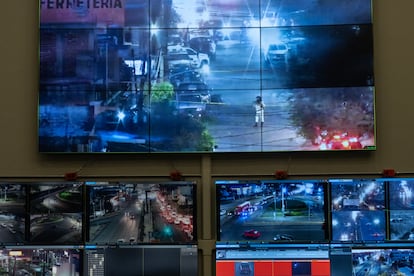
A week later, criminals attacked one of the three municipal police stations, just on the other side of the city, in San Juan de la Vega, the most important community in the north. “Their vans arrived with armed people, attacking.... Four of our people fell, injured; they burned any number of pickup trucks. But we neutralized a leader from the Scorpions,” he explains.
In Celaya, the local criminal group’s alliance with outside groups and the hiring of foreign mercenaries is no longer surprising; the situation parallels that of other Mexican states like Michoacan. Here, it has not only been the Scorpion group. Officers have also detected the presence of former Colombian military personnel. Chief Rivera believes that the way forward is to improve cooperation with the surrounding towns. Ultimately, his officers work as far as the city’s limits. In terms of security, of the eight towns that make up the metropolitan area, Celaya is close to two of them.
During the night patrol with the police, Javier and other colleagues talk about the case of the Colombians. The agent, as big as a willow trunk, says that “Colombian paramilitaries, lancers and explosives have come here.” He recalls the car bomb that exploded in the city last year, injuring nine national guardsmen and killing one. The officer does not know if that car had been prepared with them in mind or not. The criminals gave notice about the car, and the National Guard arrived first.
Next to the little piles of glass at the end of the dirt road, he, Javier and two others recall that Colombians were also involved in the Pelavacas case. “After the attack, looking at the C-4 cameras, we arrived at a house in a subdivision near here and we found uniforms and so on,” says Javier. “They had gone to change there. And the uniforms were like that, with Velcro to put their names on. And on the labels it said, ‘made in Colombia,’” he notes.

Sign up for our weekly newsletter to get more English-language news coverage from EL PAÍS USA Edition
Tu suscripción se está usando en otro dispositivo
¿Quieres añadir otro usuario a tu suscripción?
Si continúas leyendo en este dispositivo, no se podrá leer en el otro.
FlechaTu suscripción se está usando en otro dispositivo y solo puedes acceder a EL PAÍS desde un dispositivo a la vez.
Si quieres compartir tu cuenta, cambia tu suscripción a la modalidad Premium, así podrás añadir otro usuario. Cada uno accederá con su propia cuenta de email, lo que os permitirá personalizar vuestra experiencia en EL PAÍS.
¿Tienes una suscripción de empresa? Accede aquí para contratar más cuentas.
En el caso de no saber quién está usando tu cuenta, te recomendamos cambiar tu contraseña aquí.
Si decides continuar compartiendo tu cuenta, este mensaje se mostrará en tu dispositivo y en el de la otra persona que está usando tu cuenta de forma indefinida, afectando a tu experiencia de lectura. Puedes consultar aquí los términos y condiciones de la suscripción digital.
More information
Archived In
Últimas noticias
Most viewed
- Sinaloa Cartel war is taking its toll on Los Chapitos
- Oona Chaplin: ‘I told James Cameron that I was living in a treehouse and starting a permaculture project with a friend’
- Reinhard Genzel, Nobel laureate in physics: ‘One-minute videos will never give you the truth’
- Why the price of coffee has skyrocketed: from Brazilian plantations to specialty coffee houses
- Silver prices are going crazy: This is what’s fueling the rally
